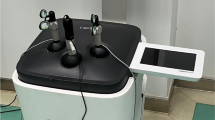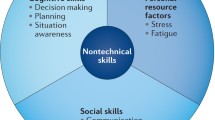Abstract
In pursuit of improving the quality of residents’ education, the Southeastern Section of the American Urological Association (SES AUA) hosts an annual robotic training course for its residents. The workshop involves performing a robotic live porcine nephrectomy as well as virtual reality robotic training modules. The aim of this study was to evaluate workload levels of urology residents when performing a live porcine nephrectomy and the virtual reality robotic surgery training modules employed during this workshop. Twenty-one residents from 14 SES AUA programs participated in 2015. On the first-day residents were taught with didactic lectures by faculty. On the second day, trainees were divided into two groups. Half were asked to perform training modules of the Mimic da Vinci-Trainer (MdVT, Mimic Technologies, Inc., Seattle, WA, USA) for 4 h, while the other half performed nephrectomy procedures on a live porcine model using the da Vinci Si robot (Intuitive Surgical Inc., Sunnyvale, CA, USA). After the first 4 h the groups changed places for another 4-h session. All trainees were asked to complete the NASA-TLX 1-page questionnaire following both the MdVT simulation and live animal model sessions. A significant interface and TLX interaction was observed. The interface by TLX interaction was further analyzed to determine whether the scores of each of the six TLX scales varied across the two interfaces. The means of the TLX scores observed at the two interfaces were similar. The only significant difference was observed for frustration, which was significantly higher at the simulation than the animal model, t (20) = 4.12, p = 0.001. This could be due to trainees’ familiarity with live anatomical structures over skill set simulations which remain a real challenge to novice surgeons. Another reason might be that the simulator provides performance metrics for specific performance traits as well as composite scores for entire exercises. Novice trainees experienced substantial mental workload while performing tasks on both the simulator and the live animal model during the robotics course. The NASA-TLX profiles demonstrated that the live animal model and the MdVT were similar in difficulty, as indicated by their comparable workload profiles.





Similar content being viewed by others
References
Duchene DA, Rosso F, Clayman R, McDougall EM, Winfield HN (2011) Current minimally invasive practice patterns among postgraduate urologists. J Endourol Endourol Soc 25(11):1797–1804
Thiel DD, Lannen A, Richie E, Dove J, Gajarawala NM, Igel TC (2013) Simulation-based training for bedside assistants can benefit experienced robotic prostatectomy teams. J Endourol Endourol Soc 27(2):230–237
Hart SGNASA (2006) Task Load Index (NASA-TLX); 20 years later. Proc Human Factors Ergonom 50:904–908
Thiel DD, Patel VR, Larson T, Lannen A, Leveillee RJ (2013) Assessment of robotic simulation by trainees in residency programs of the southeastern section of the American urologic association. J Surg Educ 70(5):571–577
Ruparel RK, Taylor AS, Patel J et al (2014) Assessment of virtual reality robotic simulation performance by urology resident trainees. J Surg Educ 71(3):302–308
Grover S, Tan GY, Srivastava A, Leung RA, Tewari AK (2010) Residency training program paradigms for teaching robotic surgical skills to urology residents. Curr Urol Rep 11(2):87–92
Smith R, Truong M (2013) Simulation in robotic surgery: a comparative review of simulators of the da Vinci. Modelbenders Press, Oviedo, FL
Lerner MA, Ayalew M, Peine WJ, Sundaram CP (2010) Does training on a virtual reality robotic simulator improve performance on the da Vinci surgical system? J Endourol Endourol Soc 24(3):467–472
Kenney PA, Wszolek MF, Gould JJ, Libertino JA, Moinzadeh A (2009) Face, content, and construct validity of dV-trainer, a novel virtual reality simulator for robotic surgery. Urology 73(6):1288–1292
Perrenot C, Perez M, Tran N et al (2012) The virtual reality simulator dV-Trainer((R)) is a valid assessment tool for robotic surgical skills. Surg Endosc 26(9):2587–2593
Hoffman MS (2012) Simulation of robotic hysterectomy utilizing the porcine model. Am J Obstet Gynecol 206(6):523 e521–522
Acknowledgments
The authors would like to cordially thank members of Global Robotic Institute Mrs. Ashley Fialkowski and Mrs. Kim Straw for their assistance in obtaining the questionnaires from participants.
Author information
Authors and Affiliations
Corresponding author
Ethics declarations
Conflict of interest
Dr Vipul Patel is a consultant for MIMIC Technologies, Inc.
Appendices
Appendix 1: Robotic Simulator Questionnaire

Appendix 2: NASA TASK Load Index

Rights and permissions
About this article
Cite this article
Mouraviev, V., Klein, M., Schommer, E. et al. Urology residents experience comparable workload profiles when performing live porcine nephrectomies and robotic surgery virtual reality training modules. J Robotic Surg 10, 49–56 (2016). https://doi.org/10.1007/s11701-015-0540-1
Received:
Accepted:
Published:
Issue Date:
DOI: https://doi.org/10.1007/s11701-015-0540-1




